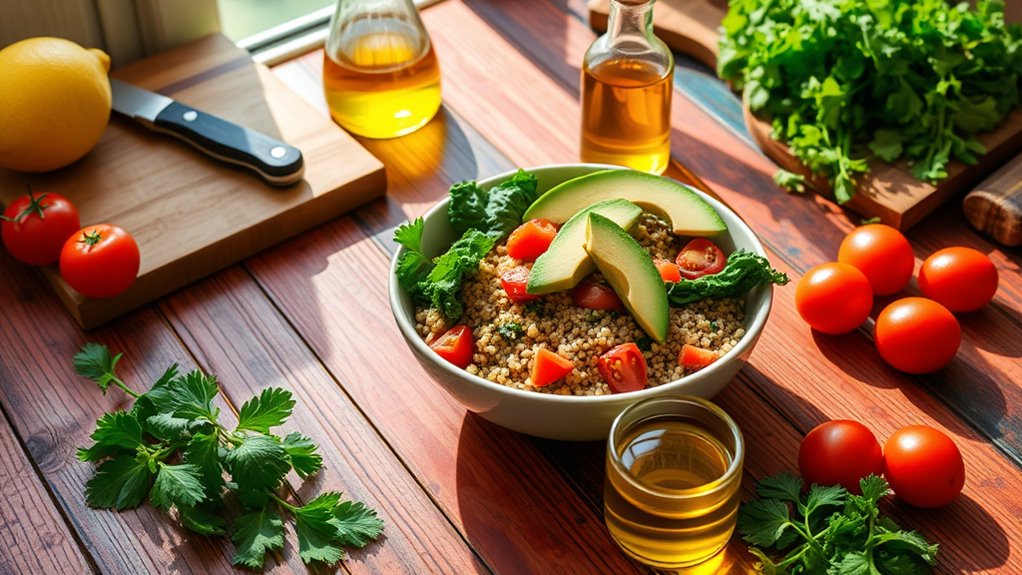These Nutritional Tweaks Could Transform Your Diet
To transform your diet, focus on high-protein, fiber-rich foods that keep you feeling full. Personalize your nutrition with tailored meal plans and track your habits for better results. If you’re using GLP-1 RA treatments, integrate them responsibly while managing side effects through smaller meals. Don’t forget about nutrient-dense foods that boost your energy. Embrace sustainable eating habits and plan meals to reduce waste. Stick around, and you’ll uncover more essential tips and insights!
Key Takeaways
- Incorporate high-protein foods like dairy and legumes in every meal to enhance satiety and regulate appetite hormones effectively.
- Pair protein with fiber-rich foods, such as oats, to promote fullness and slow digestion for better weight management.
- Utilize personalized nutrition solutions, like mobile apps and genetic testing, to create tailored meal plans that support health goals.
- Focus on a balanced macronutrient distribution—carbohydrates, proteins, and fats—to regulate metabolism and maintain long-term health.
- Adopt sustainable eating habits, such as choosing local produce and minimizing food waste, to benefit both personal health and the planet.
Emphasize Protein and Fiber for Satiety
When you aim to feel fuller for longer, emphasizing protein and fiber in your diet can make a significant difference. Incorporating smart nutrition tips, focus on high-protein foods like dairy and legumes, which not only enhance satiety but also influence hormones that control appetite. Aim for meals with at least 30 grams of protein to maximize these effects. Additionally, consider that SCIRP publishes peer-reviewed articles on nutrition science that can provide further insights into effective dietary strategies. Pairing protein with fiber-rich foods like oats can further boost your sense of fullness, as fiber expands in your stomach and slows digestion. This combination helps you feel satisfied without overeating, making it easier to manage your weight. Furthermore, nutrient synergy can amplify the effects of these foods, leading to even greater energy levels throughout the day.
Explore Personalized Nutrition Solutions
How can personalized nutrition transform your dietary habits? By leveraging technology like AI and genetic testing, you can create a diet tailored just for you. Mobile apps track your eating habits and adjust recommendations based on your unique preferences and health metrics. Recent studies have shown that personalized nutrition programs can lead to significant improvements in health outcomes, including reductions in calorie intake and body fat. Additionally, incorporating effortless ways to boost your nutrient intake daily can further support your dietary transformation.
| What You Get | How It Helps |
|---|---|
| Customized Diet Plans | Aligns with your genetic makeup |
| Real-Time Adjustments | Adapts to your daily activities |
| Personalized Guidance | Supports long-term adherence |
With these tools, you can optimize your nutrition, enhance your well-being, and make informed choices. Personalized nutrition isn’t just a trend; it’s a powerful way to invest in your health and achieve your dietary goals.
Integrate GLP-1 RA Treatments Responsibly
When integrating GLP-1 RA treatments into your routine, it’s vital to focus on nutritional management strategies that align with your health goals. You might experience side effects like nausea or reduced appetite, so addressing these issues with a balanced diet becomes essential. A balanced diet supports natural GLP-1 release, enhancing the effectiveness of your treatment. Additionally, ensuring adequate intake of essential vitamins can help mitigate any deficiencies that may arise from reduced food intake during treatment.
Nutritional Management Strategies
Integrating GLP-1 receptor agonist (RA) treatments into your nutritional management plan can considerably enhance your overall health and treatment outcomes. Focus on a balanced diet rich in whole, nutrient-dense foods to support your well-being. Prioritize fiber-rich options to promote satiety and help regulate blood sugar levels. Staying hydrated is essential for peak medication efficacy, so drink plenty of water. Make sure you’re getting enough protein at every meal to maintain muscle mass, especially since appetite suppression can be a concern. Additionally, consider the importance of managing side effects as part of your nutritional strategy. Regular meal timing can stabilize blood sugar levels, making it easier to manage your condition. It’s crucial to recognize that hidden nutrient deficiencies can also contribute to fatigue and impact your energy levels. Collaborate with a dietitian to create a personalized plan that addresses your unique needs and supports long-term health habits.
Addressing Side Effects
While managing your GLP-1 receptor agonist (RA) treatment, it’s vital to address potential side effects effectively to maintain your treatment journey.
Common side effects, like nausea, vomiting, diarrhea, and constipation, affect 40-70% of patients. To lessen these effects, consider gradual dose escalation, allowing your body to adapt. Eating smaller meals and avoiding spicy or acidic foods can also help. Incorporating natural foods known to ease bloating can further support your digestive health. Effective management of GI AEs is crucial for treatment adherence and enhancing quality of life.
Communication with your healthcare provider is important; report side effects early for better management. They can customize a plan tailored to your needs.
Discover the Benefits of Nutrient-Dense Foods
Nutrient-dense foods offer a powerful way to boost your health with every meal. These foods provide essential vitamins, minerals, lean proteins, and healthy fats without excessive calories.
Incorporating them into your diet can lead to numerous benefits:
-
Increased Energy: Leafy greens and fatty fish support your energy levels and immune function.
-
Disease Prevention: Regularly eating these foods can lower your risk of chronic diseases like heart disease and diabetes.
-
Weight Management: Nutrient-dense options help you feel full longer, making it easier to manage your weight.
Leverage Technology for Tailored Nutritional Insights
As you navigate your nutritional journey, leveraging technology can provide invaluable insights tailored specifically to your needs.
AI algorithms analyze your health records and dietary habits, creating personalized nutrition plans that adapt over time. Machine learning identifies your unique dietary patterns, helping you achieve sustainable lifestyle changes.
Wearable devices track health metrics like heart rate and glucose levels, giving you real-time feedback to inform your choices. Integrating mobile apps allows for continuous monitoring of your dietary intake, while instant alerts keep you aware of dietary impacts.
Genetic testing reveals susceptibilities to dietary sensitivities, ensuring your meals align with your body’s needs. With these tools, you can make informed decisions to optimize your health and reach your nutrition goals.
Transition to a Plant-Centric Diet
Embracing technology for personalized nutrition can set the stage for significant dietary changes, including adopting a plant-centric diet.
Making this shift can bring numerous health benefits, and you can start with simple steps:
-
Start Gradually: Introduce plant-based meals like “Meatless Mondays” to ease into the diet.
-
Diversify Proteins: Experiment with beans, lentils, tofu, and nuts to keep your meals interesting and nutritious.
-
Incorporate Whole Grains: Swap refined grains for whole grains to enhance your overall health.
Manage Macronutrients for Weight Maintenance
To maintain a healthy weight, managing your macronutrients is essential, especially since the right balance can enhance your overall well-being. Aim for carbohydrates to make up 45-65% of your daily calories for energy, while protein should account for 15-25% to promote satiety and muscle repair. Healthy fats should comprise 20-35%, vital for vitamin absorption.
| Macronutrient | Recommended Percentage | Role in Diet |
|---|---|---|
| Carbohydrates | 45-65% | Energy source |
| Protein | 15-25% | Satiety and repair |
| Fats | 20-35% | Vitamin absorption |
Balancing these macronutrients helps regulate metabolism and maintain your weight effectively while focusing on nutrient-dense foods for long-term health.
Adopt Sustainable Eating Habits
Adopting sustainable eating habits not only benefits your health but also contributes positively to the planet.
By making mindful choices, you can reduce your carbon footprint while enjoying a diverse and nutritious diet. Here are three simple ways to start:
- Choose Local and Seasonal: Buy produce from local farmers to support your community and minimize transportation emissions.
Seasonal fruits and veggies are often cheaper and more flavorful.
- Embrace Plant-Based Options: Incorporate more plant-based meals into your diet.
They’re rich in nutrients and can lower your risk of chronic diseases.
- Reduce Food Waste: Use leftovers creatively and plan meals to minimize waste.
This not only saves money but also helps conserve resources.
Start small, and you’ll make a big impact!
Frequently Asked Questions
How Can I Incorporate More Protein Into My Daily Meals?
You can incorporate more protein by adding high-protein cereals for breakfast, lean meats or legumes at lunch, and fish or tofu at dinner. Snacks like Greek yogurt or nuts will also boost your protein intake.
What Are the Best Fiber Sources for a Balanced Diet?
Picture a vibrant bowl filled with avocados, berries, and crunchy almonds. To balance your diet, incorporate high-fiber foods like lentils, quinoa, and Brussels sprouts. They’ll keep you satisfied and support your overall health.
Are There Side Effects of GLP-1 RA Treatments I Should Know About?
Yes, there are side effects of GLP-1 RA treatments you should know about. Nausea, diarrhea, and stomach discomfort are common. Rare but serious issues like pancreatitis and kidney damage can occur, so monitoring is essential.
How Do I Identify Nutrient-Dense Foods at the Grocery Store?
Imagine a treasure hunt in the grocery store. You’ll spot nutrient-dense foods by shopping the perimeter, choosing vibrant colors, selecting whole grains, and avoiding processed items. Remember, variety’s your best ally for a nutrient-rich diet!
What Are Some Easy Plant-Based Recipes for Beginners?
You can start with simple recipes like tofu scramble for breakfast, chickpea pasta salad for lunch, and lentil chili for dinner. Snacks like chickpea fritters are easy to make and delicious. Enjoy experimenting!
References
- https://khni.kerry.com/trends-and-insights/ten-key-health-and-nutrition-trends-of-this-year/
- https://www.learnprompt.org/deepseek-prompts/
- https://nutritionsource.hsph.harvard.edu/healthy-weight/best-diet-quality-counts/
- https://www.studocu.com/en-us/messages/question/10884033/create-a-thoughtful-response-to-out-of-the-websites-listed-in-the-discussion-board-i-would-feel
- https://pmc.ncbi.nlm.nih.gov/articles/PMC7689688/
- https://www.scirp.org/journal/paperinformation?paperid=85681
- https://pmc.ncbi.nlm.nih.gov/articles/PMC3662086/
- https://imperialbrc.nihr.ac.uk/2024/07/11/high-fibre-food-intake-promotes-satiation/
- https://www.lingexp.uni-tuebingen.de/z2/Morphology/baroni.rows
- https://pubmed.ncbi.nlm.nih.gov/23885994/

